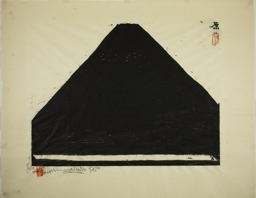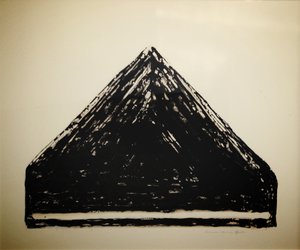Carol Chase Bjerke’s new work is an excellent showing of what can be done in and out of constraints. It feels almost silly even saying that, as Carol’s work has, for as long as I have seen it, existed outside of the bounds of the photography I was familiar with. She’s built a long history of using unorthodox cameras, developing techniques, subject matter, and even developed a new medium in the realm of photography with her limnographs. With these three new pieces she upheld that desire to work beyond the medium, but did so within a surprisingly narrow frame of reference.
“Hara, A Line at the Foot of Mt. Fuji”, printed in 1964 by Shikō Munakata, serves as the direct inspiration for Bjerke’s piece. I would go further to call it a translation from the media of woodblock to limnograph. Looking at the two side by side it becomes clear that Carol’s technique has something to offer the composition.


I think the most interesting distinction between the two is the presence they each give off. Shikō’s mountain is imposing, dense, and one gets the feeling, too large to even fit in the frame he has given it. We’re seeing only a cropping of Mt. Fuji’s grandeur, and yet its power is unquestionable. Carol’s mountain is powerful to be sure, but there is a softness there. The streaking where the developing fluid breaks away reveals an aging, flawed, and resoundingly beautiful peak. Unlike Shikō’s piece there’s vulnerability accompanying intensity.

I have not seen Mt. Fuji in person, and as a man born and raised in the midwest I spend very little time with mountains. The closest analogue I have spent any real time with are the bluffs at Devil’s Lake in Wisconsin. As a kid we would go once a year to take in some scenery, swim in the lake, and climb the rocks to the top. The height of the bluffs always seemed staggering at around 500ft. From the bottom nearly impossible to take in the entirety of the scope of it. Mt. Fuji is 12,388. Always good to give yourself perspective.
Aedric Donovan
Gallery Associate
